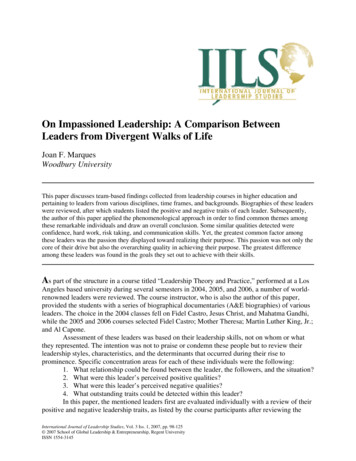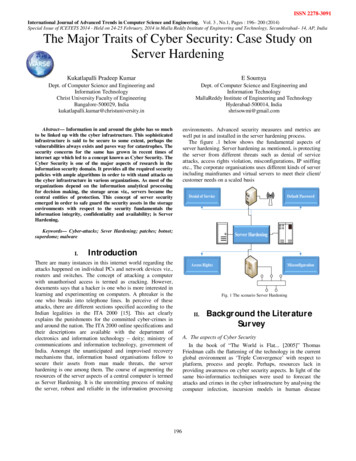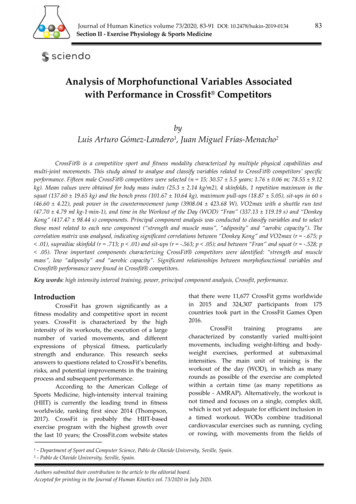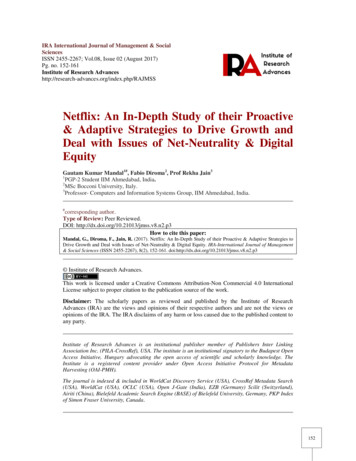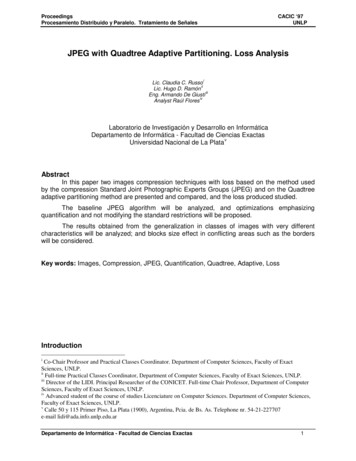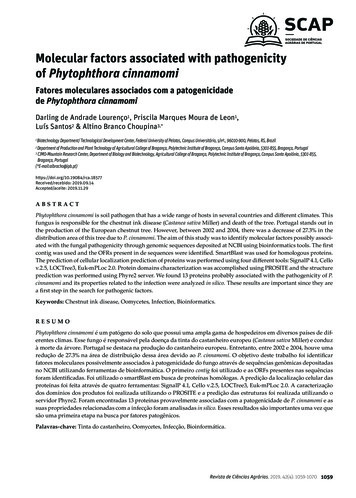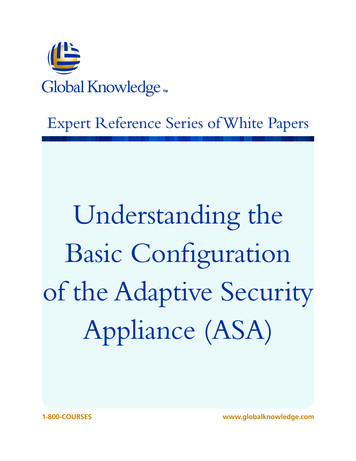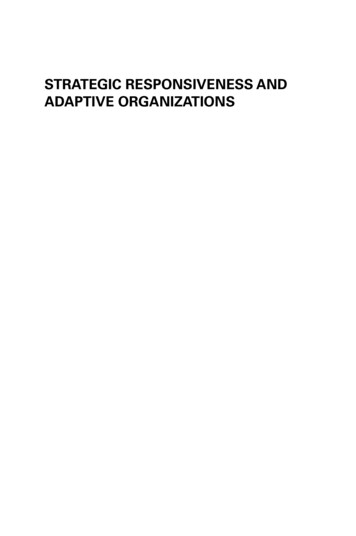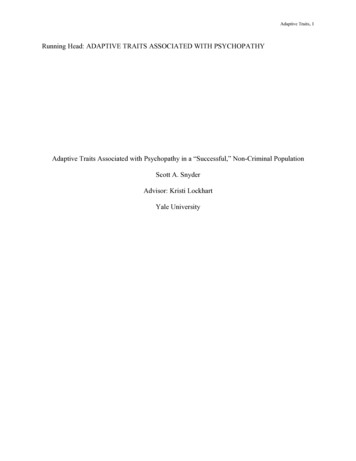
Transcription
Adaptive Traits, 1Running Head: ADAPTIVE TRAITS ASSOCIATED WITH PSYCHOPATHYAdaptive Traits Associated with Psychopathy in a “Successful,” Non-Criminal PopulationScott A. SnyderAdvisor: Kristi LockhartYale University
Adaptive Traits, 2AbstractRecently, a growing body of research has begun to examine the existence of “successful”psychopaths – those who remain functional and non-institutionalized in society. Using the PPIR, a self-report measure of psychopathy, this study investigated which psychopathic traits werepresent in a self-evidently “successful” population (N 40) at an elite, Ivy League university.Students scoring higher on the “Fearless Dominance” scale (PPI-I) were more likely to beyounger, more politically active on campus, and oriented toward narcissistic careers in whichsocial manipulation and risk-taking are crucial. They also displayed a more positive attributionalstyle and were more tolerant of cheaters.Students scoring higher on the “Self-CenteredImpulsivity” scale (PPI-II) exhibited more risk-acceptant, reward-seeking behavior in a cardgame and reported more disciplinary problems. Females scored higher than normal on the PPI-I,while males scored lower than normal. Implications for the “successful” psychopathy conceptand the primary/secondary distinction in psychopathy are discussed.
Adaptive Traits, 3Adaptive Traits Associated with Psychopathy in a “Successful,” Non-Criminal PopulationEarly History and the DSMThroughout the history of the discipline of psychology, the construct of psychopathy hasbeen both one of the most researched as well as “one of the most enigmatic conditions in thefield” (Lilienfeld & Widows, 2005). Evidence for the disorder can be found as far back as theearly nineteenth century (Pinel, 1801, as cited in Arrigo & Shipley, 2001). During the nineteenthand early twentieth centuries, many psychiatrists, psychologists, physicians, and otherresearchers contributed to the body of knowledge on the condition, but the wide array ofattributes and characterizations that they produced amounted to a jumbled conception ofpsychopathy that included a variety of symptoms and disorders (Lilienfeld & Widows, 2005).Through the twentieth century, and especially since Hervey Cleckley’s emergence in thefield, the condition has been defined with greater specificity. Cleckley’s (1941) tome, The Maskof Sanity, established sixteen standard personality features as criteria for a diagnosis ofpsychopathy; these include superficial charm, lack of empathy, self-centeredness, guiltlessness,and lack of anxiety and remorse, among others. Cleckley’s work on the topic of psychopathyalso contributed to the characterization of antisocial personality disorder, which is thought toencompass some aspects of psychopathy, in the Diagnostic and Statistical Manual of MentalDisorders (Lilienfeld & Widows, 2005). Recent versions of the DSM have come to emphasizethe behavioral traits associated with psychopathy, which are more strongly associated withASPD; this limited focus has, to a certain extent, come at the expense of the personality traits.Despite significant overlap, psychopathy and ASPD are two distinct disorders.Part of the reason for this blurring between ASPD and psychopathy and the consequentintuitive association between psychopathy and criminality is the fact that many psychopaths
Adaptive Traits, 4indeed interact with the criminal justice system on some level (O'Toole, 2007). Moreover, thepopular conception of the psychopath is often of a dangerously violent criminal—a conceptionbolstered by the media (Lykken, 1996). In particular, a lack of remorse—an emotional deficit—and various types of antisocial behavior make psychopaths more likely to commit many types ofcrimes. Nonetheless, a diagnosis of psychopathy does not guarantee criminal behavior; as thediscussion that follows will explicate, different psychopathic personality traits augur differentbehavioral manifestations of the disorder.The PCL-R and Psychopathy’s Multiple FactorsRobert Hare’s contribution to the field, both singly (1980) and with colleagues (1991),further refined our conception of the many facets of psychopathy with the Psychopathy Checklistand later the Psychopathy Checklist – Revised; the latter has become the seminal diagnosticmeasure of psychopathy. Since its inception as a measure, there have been many attempts tocatalogue the dimensions of psychopathy via factor analysis; such efforts have revealedanywhere between two and seven factors (Neumann, Kosson, & Salekin, 2007). Althoughresearchers disagree on the precise number, it is now clear that at least two dimensions underliethe construct of psychopathy. Thus, subsequent measures have, at a minimum, differentiatedbetween at least these two factors in their scales; the two most commonly used factorsdistinguish the emotional, personality attributes from the behavioral attributes of psychopathy.In fact, the PCL, and later the PCL-R, were designed at least partly to address this dichotomywithin the construct of psychopathy (Hare, Hart, & Harpur, 1991). As Hare et al. (1991) note,prior to the PCL-R, psychopathy was arguably too strongly associated with ASPD; despitecriticism that the DSM-III-R criteria for ASPD were limited to behavioral items that neglected
Adaptive Traits, 5the more internal personality traits of the disorder, the DSM-IV continued in this vein, andpsychopathy thus continued to be associated with this purely behavioral diagnostic measure.The PPI-R and its Two FactorsDespite the progress achieved with the PCL-R, certain drawbacks remained; in particular,the measure requires an interview, is time-consuming, and relies extensively on background data(Lilienfeld & Andrews, 1996). Among the newer measures that effectively accommodate themultiple factors of psychopathy were a variety of self-report, expert rating, and othermethodologies (Forth & Book, 2007). From these, the Psychopathic Personality Inventoryemerged as an effective self-report measure of psychopathy (Lilienfeld & Widows, 2005). Nowrevised, the PPI-R measures psychopathy on two main factors: Factor 1, or PPI-I, has beencharacterized as measuring “Fearless Dominance,” which reflects more personality-based traits;Factor 2, or PPI-II, has been labeled variously “Impulsive Antisociality” or “Self-CenteredImpulsivity” and is taken to reflect the more behavioral traits associated with psychopathy.Sometimes considered a third factor, “Coldheartedness” stands distinct from the FearlessDominance and Self-Centered Impulsivity categories (Benning et al., 2003; Lilienfeld &Widows, 2005).The two main factors of the PPI-R map conceptually onto the twocorresponding factors of the PCL-R (i.e. PPI-I correlates moderately with Factor 1 of the PCL-R,and PPI-II correlates moderately with Factor 2 of the PCL-R); however, while the factors of thePCL-R correlate relatively well with each other, the two main factors of the PPI-R areuncorrelated, suggesting the existence of two “fundamentally separate dispositional dimensions”under the umbrella of psychopathy (Benning et al. 2003). The PPI-R has been well validated foruse on both offender (Berardino et al., 2005; Patrick et al., 2006) and community (Lilienfeld &Andrews, 1996) samples.
Adaptive Traits, 6Whereas research on psychopathy has traditionally focused on how it relates tocriminality (Harris & Rice, 2007), with the advent of valid self-report measures like the PPI-R,the literature has expanded, somewhat marginally, to include the general population (e.g.,Benning et al., 2003; Mullins-Nelson et al., 2006; Coid et al., 2009). The present study is in partan attempt to contribute to this growing trend of broadening the study of psychopathy.The “Successful” PsychopathPreempting current research into the multiple factors of psychopathy, andnotwithstanding psychopathy’s imprecise association with ASPD in the DSM, Cleckley (1941)noted that not all psychopaths exhibit antisocial behavior. As Lilienfeld and Widows (2005)paraphrase: “at least some psychopathic individuals have seemingly achieved a reasonablysuccessful adjustment to society.” This notion has led some researchers to seek out “successful”psychopaths. Widom (1977) began this line of inquiry by using newspaper advertisements toattract psychopaths who remained at large in the general population. Widom’s advertisementswere effective, as the participants in her study exhibited psychopathic traits according to severalpersonality measures. These results demonstrated that not all psychopaths are institutionalized;the construct of psychopathy is relevant in noncriminal populations; and noncriminalpsychopaths can be identified for research purposes. There is now a growing literature on the“successful” psychopath, including theories of how certain psychopathic traits maycounterintuitively prove to be evolutionarily adaptive in certain situations (Hall & Benning,2006).This potentiality should not be surprising. For instance, Lykken (1996) posits a theory ofpsychopathy such that psychopaths are simply individuals with a “low fear quotient”—they feelsome emotions normally, but not fear. Lykken (1996) suggests that because proper socialization
Adaptive Traits, 7depends on conditioning people via punishment, and because this conditioning is only effectivewhen people fear these punishments, individuals relatively deficient in fearfulness becomerelatively more difficult socialize. However, Lykken (1996) maintains that such socialization,while infrequent, can occur. In these rare cases, “a child with a low fear quotient, whose parentsnonetheless succeed in instilling the essentials of good citizenship, would grow up to be the kindof person one would like to have on hand when stress and danger threaten” (Lykken, 1996). Inother words, without proper socialization, an individual who suffers from a low fear quotientmay become an antisocial, deviant psychopath; but with the right upbringing, these psychopathsmay become exceptional benefactors to society.Thus, certain professions, particularly those that may involve risk-taking and offer powerand substantial personal benefit, may not only attract psychopathic personalities, but indeedsome professionals may benefit from psychopathic traits; these could include test pilots,stuntmen, or even hedge fund managers. Recent scandals in the business world lend credence tothis theory, as high-ranking executives, after long success, have been exposed as cheaters andliars (e.g. Bernie Madoff and the executives at Enron).Such risky personalities are evenportrayed in popular culture, for instance by Leonardo DiCaprio, playing real-life conman FrankAbagnale, Jr. in the movie Catch Me if You Can (2002). These examples fit with one possiblystereotypical conception of the psychopath as a conman (Alvarez, 1999); more generally, theysupport the notion of “successful” psychopathy.Indeed, Babiak and Hare's (2006) book, Snake in Suits: When Psychopaths Go to Work,describes in vivid detail examples of psychopaths successfully infiltrating businesses, scammingchurches, and performing other reprehensible yet lucrative acts. These individuals, upon closeexamination, clearly exhibit psychopathic personalities, yet they operate anonymously in regular
Adaptive Traits, 8society, their deviance unbeknownst to those around them until it is too late. Of course, thesecases may in fact be criminal, but simply undetected. Nonetheless, they underscore the need toinvestigate the “successful” psychopath.Primary versus Secondary PsychopathyHistorically, many researchers, drawing inspiration from Blackburn (1975), havedifferentiated between primary and secondary psychopaths (e.g., Jakobwitz & Egan 2006;Levenson et al., 1995; McHoskey, 1998).Coyne and Thomas (2008) define primarypsychopaths as “individuals who generally show low levels of anxiety, empathy, fearlessness andemotion due to some intrinsic deficit rather than due to environmental or emotional difficulties;”on the other hand, “secondary psychopaths show more impulsiveness, anxiety, empathy, andguilt than their primary counterparts.” Currently, however, primary psychopathy seems to reflectthe most common conception of psychopathy, while secondary psychopathy may be bettercharacterized as a form of sociopathy, or a subset of primary psychopathy.Ross and Rausch (2001) have elaborated that primary and secondary psychopathyproduce different levels of life success. In their study of a college sample, they found thatprimary psychopathy, which maps well onto the first factor of the PCL-R, correlated positivelywith hypercompetition; conversely, secondary psychopathy, which aligns with the second factorof the PCL-R, did not correlate with hypercompetition, instead correlating negatively withcooperation and goal engagement (Ross & Rausch, 2001). Ross and Rausch (2001) argue thattheir results suggest that primary psychopaths will be more successful than secondarypsychopaths. Part of the reason for this may be that Factor 1 of the PCL-R, and by associationprimary psychopathy, is characterized by “the core personality traits of psychopathy,” whereasFactor 2, and thus secondary psychopathy, reflects more “social deviance,” or a more behavioral
Adaptive Traits, 9manifestation of antisociality (Ross & Rausch, 2001). This theory of two groups of psychopaths,one more successful than the other, has been supported by subsequent research (e.g., Coyne &Thomas, 2008; Ishikawa et al., 2001).Research on “Successful” PsychopathyAlthough the majority of research on psychopathy has involved incarcerated populations,beginning with Widom (1977), some researchers took to identifying criminally active but atlarge psychopaths, characterizing these individuals as “successful” for their ability to avoidimprisonment (e.g., Ishikawa et al., 2001; Levenson, Kiehl, & Fitzpatrick, 1995). More recently,limited research has examined the “successful” psychopath in order to clarify what psychopathictraits may in fact be adaptive. Levenson (1992) suggested that this may be the case when heposited that psychopaths, rather than being nonconformists in a sociological sense, products ofpoor socialization, or the result of physiological deficits in behavioral inhibition, instead simplypossess a unique life philosophy; this philosophy consists of a selfish disregard for society’snorms and moral values in favor of abject narcissism. Perhaps most importantly, Levenson(1992) further notes that there is nothing inherently self-destructive in this philosophy; in fact,several behaviors that likely result from it—e.g. lying, manipulating others, egocentricity, etc.—could prove to be adaptive.The adaptiveness of certain psychopathic traits has been tested empirically withconflicting results. Levenson et al., in a study of university students, showed that thrill andadventure seeking were not correlated with psychopathy; this, the authors argued, dispelled thetheory that psychopathic traits breed, in some cases, a “hero” complex (Levenson, et al., 1995;Lykken, 1996). Yet, Levenson et al.’s (1995) data do reveal positive correlations betweendisinhibition and boredom susceptibility and both primary and secondary psychopathy—though
Adaptive Traits, 10the correlations were stronger with primary psychopathy. These traits, rather than being adaptivein the sense that they prompt individuals to take reckless risks and become heroes, may insteadlead simply to increased activity, and therefore productivity. More recently, Ullrich, Farrington,and Coid (2008) claimed to disconfirm the hypothesis that various psychopathic traits areassociated with life success as measured by “status and wealth” or “successful intimaterelationships.” However, their sample consisted entirely of 48-year-old men who all began in a“working-class, inner-city” environment, which is far from representative; furthermore,measuring a psychopath’s success by his degree of “successful intimate relationships” seemssomewhat self-defeating.Conversely, several studies have found substantial evidence for adaptive traits associatedwith psychopathy. Ross and Rausch (2001), for example, found primary psychopaths to behighly competitive and low in self-handicapping—they didn’t “place obstacles to [their] ownsuccess in order to preserve or enhance self-esteem”—both of which, one could argue, arepotentially adaptive traits. In a study on autonomic stress reactivity and executive function byIshikawa et al. (2001), “successful”—non-incarcerated—psychopaths exhibited better executivefunction and performed better on the Wechsler Memory Scale – Revised, than both unsuccessfulpsychopaths and controls. Board and Fritzon (2005), in a study of self-evidently “successful”individuals—business managers and executives from prominent companies in the UK—foundthat their participants scored similar to psychopaths on scales of histrionic, narcissistic, andcompulsive personality disorders. Finally, Jakobwitz & Egan (2006) found a significant positivecorrelation between MACH-IV scores (a measure of machiavellianism) and psychopathy, withmost of the effect coming from primary psychopathy. They also discuss a significant increase inMACH-IV scores from past studies; they “speculate that modern western society is much more
Adaptive Traits, 11competitive and materialistic than even 20 years ago, and some degree of apparent psychopathymay be necessary to succeed in this type of society.” Given these findings, there is a need forfurther research into the “successful” psychopathy construct and the specific psychopathic traitsthat may prove to be adaptive.A Gap in the ResearchAs noted above, the study of psychopathy has expanded into the general population; thetheory of psychopathy has evolved to include a conception of the “successful” psychopath whomay function anonymously in society. However, to date, few studies have attempted to targetspecifically these successful psychopaths in the general population. Widom (1977) aimed tostudy noninstitutionalized psychopaths, but the participants in her study were nonetheless muchmore criminal than “normal;” most of the “successful” psychopaths she found been arrested,sometimes multiple times, but were convicted less often than their unsuccessful counterparts.Babiak and Hare (2006) continued in this tradition, examining behaviorally deviant but uncaughtpsychopaths. Yet, most research has failed to uncover individuals who refrain from the illicitand illegal behavior of those described in Snakes in Suits (2006) while still exhibiting personalitytraits associated with psychopathy. Board and Fritzon (2005), in their study of businessmen inthe UK, came the closest, but their study was not explicitly aimed at examining psychopathy intheir successful population.The “successful” psychopaths that the current study has in mind are men or women whoare aggressive, lacking in empathy, remorse, and fearfulness, but who nonetheless conform tosociety's norms of behavior.These traits would in fact aid these individuals in their lifeendeavors, helping them to “succeed” more easily where others would be hindered by their morecautious, empathic, and guilt-ridden personalities; indeed, these “successful” psychopaths may
Adaptive Traits, 12be especially proficient in certain professions and at certain tasks. In light of this missing piecein the literature, the present study aims to analyze an overtly and intuitively “successful”population and examine the potential correlates of this particular brand of “successful”psychopathy. I have proceeded based on the following hypotheses:1. I predicted that administration of the PPI-R would reveal a greater prevalence ofpsychopathy in the “successful” student body under investigation than is customarily found inthe general population—specifically, greater than 1%, which is nearly double the 0.6% found byCoid et al. (2009). Although the PPI-R does not provide a cutoff score (Lilienfeld & Widows,2005), an assessment of the distribution of percentiles should provide an indication of whetherthe sample under study exhibits higher-than-normal levels of psychopathy. However, I expectedin particular higher-than-typical scores on Factor 1 of the PPI-R, but not on Factor 2. This wasbased on several studies that suggest (a) primary psychopathy is strongly associated with Factor1 of the PCL-R (Ross & Rausch, 2001), (b) Factor 1 of the PCL-R is moderately correlated withFactor 1 of the PPI-R (Benning et al., 2003), and (c) primary psychopathic traits have been foundto be more adaptive than secondary psychopathic traits (Archer & Coyne, 2005; Coyne &Thomas, 2008; Ross & Rausch, 2001).2. I also expected that individuals with higher total scores on the PPI-R would displayless risk-aversion, with those who score higher on Factor 2 potentially showing more riskaversion than those who score higher on Factor 1. A finding of overall low risk-aversion wouldbe in line with the general constellation of psychopathic traits originally identified by Cleckley(1941), namely a lack of anxiety, dysfunctional experiential learning, poor behavioral inhibition,and a lack of foresight and planning. The difference according to factor would conform toLevenson et al.’s (1995) results on the difference in “trait anxiety” between primary and
Adaptive Traits, 13secondary psychopaths. Schmitt et al. (1999) previously tested risk-aversion using a gamblingtask. This task involved selecting cards from “rigged” decks, one of which was “good” and oneof which was “bad;” participants were scored according to how quickly they learned to selectfrom the “good” deck. The authors found a correlation between risk-aversion and anxiety butnot between risk-aversion and psychopathy. However, by its traditional definition in economics,Schmitt et al.’s (1999) gambling task was not truly measuring risk-aversion, but rather a form ofexperiential learning.Therefore, the current study tested risk-aversion according to itsunderstanding in economics—that is, choosing a “sure thing” over a riskier option when bothrepresent the same expected value (Binswanger, 1980).3. I believed that individuals with higher scores on Factor 1 of the PPI-R would show amore positive attributional style (Peterson et al., 1982). A positive attributional style has beenshown to protect individuals from experiencing depression (Sanjuan & Magallares, 2009);similarly, psychopaths generally show lower-than-average rates of depression (Lovelace &Gannon, 2006). However, given differences between primary and secondary psychopaths, suchthat primary psychopathy is associated with low rates of depression but secondary psychopathyis not (Vaughn et al., 2009), I expect Factor 1 of the PPI-R to correlate positively with a positiveattributional style, but not Factor 2.4. I expected participants who score high on Factor 1 of the PPI-R to judge cheaters moreforgivingly. Mealey (1995, as cited in Ross & Rausch, 2001) “suggests that psychopaths are‘cheaters’—low in cooperation and high in competition.” Ross and Rausch (2001) investigatedthis theory and proposed that secondary psychopaths are likely to be cheaters, whereas primarypsychopaths are more likely to be ‘warrior hawks’ (Baily, 1995, as cited in Ross & Rausch,2001). However, Coyne and Thomas (2008) found, to the contrary, that cheating behavior
Adaptive Traits, 14predicted primary psychopathy, and not secondary psychopathy. Ross & Rausch (2001) mayhave misinterpreted the implications of the varying levels of cooperation and competitivenessthat they found among different psychopaths. Thus, when assessing scenarios involving “fuzzy”cheating, participants who score high on Factor 1 of the PPI-R, but not those who score high onFactor 2, were expected to judge the actors in these scenarios less harshly.5. Higher scores on the PPI-R, particularly higher scores on Factor 1, were predicted tocorrelate with a greater tendency toward certain “risky,” “powerful,” professions, and morepolitical activity as an undergraduate. This was not to say that these individuals would possessambitions to become heroes; as Levenson et al. (1995) point out, this may not be an accurateconception of the psychopath’s risky, aggressive behavior. However, one could argue that highpower business executives, players on Wall Street, and nationally recognized politicians are allin “risky” professions; they are certainly in very active, powerful, charisma-driven professions.Given Board and Fritzon’s (2005) and Babiak and Hare’s (2006) surveys of psychopaths in thebusiness world, as well as the accepted general constellation of psychopathic traits, I predictedthat those who score especially high on the PPI-R, especially on Factor 1, would indicate aninterest in pursuing professions that independent raters deem more likely to attract “narcissistic,manipulative, and power-hungry” personalities.I expected that they would also be morepolitically active on campus.6. Higher scorers on the Factor 2 of the PPI-R were predicted to have had moredisciplinary problems throughout their lives. Although the sample currently under investigationis necessarily non-criminal, this does not preclude the possibility of discovering an undercurrentof antisocial behavior among those who show more psychopathic tendencies.Given thedifferences in levels of success posited by several researchers previously (e.g., Coyne & Thomas,
Adaptive Traits, 152008; Ishikawa et al., 2001), high scores on Factor 2, but not Factor 1, were expected to correlatewith discipline problems.7. Finally, I believed that higher scores on Factor 1 of the PPI-R, but not on Factor 2,would correlate with less empathic concern, as measured by a donation choice. This resultwould support the findings of Board and Fritzon (2005), who discovered a significant prevalenceof psychopathic personality traits among UK business executives, including narcissism, andJakobwitz and Egan (2006), who showed a significant positive correlation between narcissismand primary psychopathy.MethodParticipantsAdult participants were recruited from an Ivy League university through a combination offlier advertisements and online sign-up.A slight majority of participants (22) receivedexperimental research credit toward their introductory psychology course; the rest (20) were paid 5 for their time. All participants were assured that their answers remained anonymous—nameswere not collected except to verify payment—and all participants received a debriefing followingcompletion of the study. In the process of recruitment, 2 non-Yale-affiliated persons signed upfor and took part in the study; although they were paid for their time, their data are excluded inthe analysis from here on—thus, N 40.The total sample consisted of 18 men and 22 women. Participants ranged in age from 1828 years old, with a mean of 19.48 (SD 2.03). The sample included 18 White, 8 Asian, 7 Black,and 7 other/mixed-race participants. For nationality, because of imbalanced groups and thesmall overall sample size, during analysis, participants were consolidated into two groups asAmerican (32) and non-American (8), reducing self-reported specificity.
Adaptive Traits, 16MeasuresPsychopathyThe Psychopathic Personality Inventory-Revised (PPI-R; Lilienfeld & Widows, 2005)consists of 154 multiple-choice items (e.g., “It might be exciting to be on a plane that was aboutto crash but somehow landed safely”). Items are scored on a 4-point Likert scale ranging fromFalse to True; half of the items are reverse scored. The scoring book produces raw scores andpercentiles, broken down by factor: Factor 1 (PPI-I), sometimes labeled “Fearless Dominance,”includes the subscales Social Influence, Fearlessness, and Stress Immunity; Factor 2 (PPI-II),sometimes labeled “Self-Centered Impulsivity,” includes the subscales MachiavellianEgocentricity, Rebellious Nonconformity, Carefree Nonplanfulness, and Blame Externalization(Benning et al., 2003; Lilienfeld & Widows, 2005). “Coldheartedness” falls outside of the twomain factors, and will be referred to as Factor 3. As noted above, PPI-I correlates “modestly”with Factor 1 of the PCL-R, and PPI-II correlates similarly with Factor 2 of the PCL-R (Benninget al., 2003). Because of well-established gender differences in the prevalence of psychopathy(Cale & Lilienfeld, 2002), and because the PPI-R percentiles have been calculated to account forthis (Lilienfeld & Widows, 2005), percentiles will be used in place of raw scores throughout thisanalysis.This test was administered with all identifying names (i.e., any instance of “PPI-R”) onthe test materials covered with white tape. This was to preserve the integrity of the measureagainst any biases should a participant have recognized the test. In addition, it maintained a levelof discreteness with regard to the precise nature of the study—i.e., it may have caused unduepsychological distress for participants to learn, even after the fact, that they were being (hadbeen) tested for psychopathy, anonymity notwithstanding.
Adaptive Traits, 17Potential CorrelatesThe Attributional Style Questionnaire (ASQ; Peterson et al., 1982) originally consisted of12 hypothetical events, half positive (good) events and half negative (bad). Participants areasked to indicate what they feel would be a major cause of the event and then answer threequestions. The relevant question for the current study asks whether the cause of the event ismore due to something about the participant or external factors; participants answer on a 7-pointLikert scale ranging from 1 “Totally due to other people or circumstances” to 7 “Totally due tome.” For the purpose of timeliness, six events were selected for use in the current study, threepositive and three negative. The scores on the three positive and three negative items weresummed separately, and then the negative sum subtracted from the positive sum in order toproduce a continuous scale with values representing the degree to w
Indeed, Babiak and Hare's (2006) book, Snake in Suits: When Psychopaths Go to Work, describes in vivid detail examples of psychopaths successfully infiltrating businesses, scamming churche


